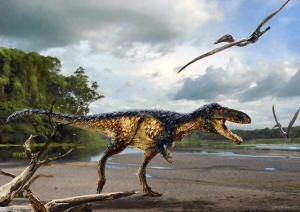|
 From
wee rex to T. rex: modest forerunner to huge predator found From
wee rex to T. rex: modest forerunner to huge predator found
 Send a link to a friend
Send a link to a friend
[March 15, 2016]
By Will Dunham
WASHINGTON (Reuters) - Fossils unearthed
in northern Uzbekistan's remote Kyzylkum Desert of a smaller, older
cousin of Tyrannosaurus rex are showing that the modest forerunners of
that famous brute had already acquired the sophisticated brain and
senses that helped make it such a horrifying predator.
|
|
 Researchers said on Monday the horse-sized Cretaceous Period
dinosaur, named Timurlengia euotica, that roamed Central Asia 90
million years ago sheds new light on the lineage called tyrannosaurs
that culminated with T. rex, which stalked North America more than
20 million years later. Researchers said on Monday the horse-sized Cretaceous Period
dinosaur, named Timurlengia euotica, that roamed Central Asia 90
million years ago sheds new light on the lineage called tyrannosaurs
that culminated with T. rex, which stalked North America more than
20 million years later.
The researchers used CT scans to look inside Timurlengia's braincase
and digitally reconstruct its brain, sinuses, nerves, blood vessels
and inner ear. The make-up of the inner ear indicated Timurlengia,
like T. rex, excelled at hearing lower frequency sounds.
Timurlengia was relatively small but boasted the advanced brain and
senses of the colossal apex predators like Tyrannosaurus rex that
lived at the end of the dinosaur age, paleontologist Steve Brusatte
of Scotland's University of Edinburgh said. "This tells us that
tyrannosaurs got smart before they got big."These traits came in
handy when tyrannosaurs had the opportunity to rise to the top of
the food chain and become very big after other large dinosaur
predator groups disappeared.
 Timurlengia, named for 14th century Central Asian conqueror
Tamerlane, was 10-13 feet (3-4 meters) long and about 600 pounds
(270 kg). T. rex reached about 42 feet (13 meters) and 7 tons.
Paleontologist Hans-Dieter Sues of the Smithsonian Institution's
National Museum of Natural History in Washington said Timurlengia
was a nimble, long-legged pursuit hunter and probably a better
runner than T. rex. "Timurlengia would be a frightening creature,
in the same way that a lion is pretty frightening to us," Brusatte
said. "But if you were somehow transported into an alternate
dimension and had a choice between facing down a Timurlengia or a T.
rex, you would go with Timurlengia anytime."
[to top of second column] |

Tyrannosaurs appeared about 170 million years ago and initially were
roughly a person's size.
Before Timurlengia's discovery, there had been a gap in the
tyrannosaur fossil record between about 100 and 80 million years ago
that had left questions about their evolution. The fact Timurlengia
was still relatively small 80 million years after tyrannosaurs first
appeared showed their immense size occurred suddenly, late in their
evolutionary history."Tyrannosaurs only became really big about 80
million years ago," Sues said.
The research appears in the Proceedings of the National Academy of
Sciences.
(Reporting by Will Dunham; Editing by Sandra Maler)
[© 2016 Thomson Reuters. All rights
reserved.]
Copyright 2016 Reuters. All rights reserved. This material may not be published,
broadcast, rewritten or redistributed.
 |